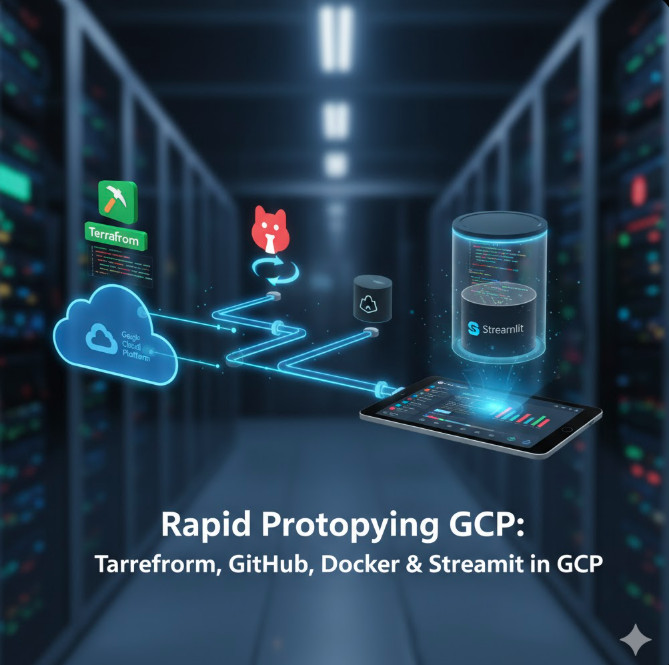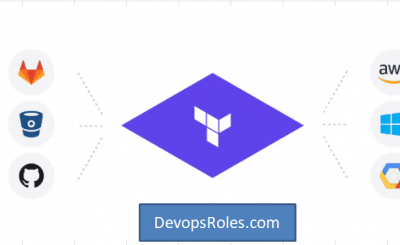In my experience as a Senior Staff DevOps Engineer, I’ve often seen deployment friction halt brilliant ideas at the proof-of-concept stage. When the primary goal is validating a data product or ML model, speed is the most critical metric. This guide offers an expert-level strategy for achieving true Rapid Prototyping in GCP by integrating an elite toolset: Terraform for infrastructure-as-code, GitHub Actions for CI/CD, Docker for containerization, and Streamlit for the frontend application layer.
We’ll architect a highly automated, cost-optimized pipeline that enables a single developer to push a change to a Git branch and have a fully deployed, tested prototype running on Google Cloud Platform (GCP) minutes later. This methodology transforms your development lifecycle from weeks to hours.
Table of Contents
- 1 The Foundational Stack for Rapid Prototyping in GCP
- 2 Step 1: Defining Infrastructure with Terraform
- 3 Step 2: Containerizing the Streamlit Application with Docker
- 4 Step 3: Implementing CI/CD with GitHub Actions
- 5 Best Practices for Iterative Development and Cost Control
- 6 Frequently Asked Questions (FAQ)
- 7 Conclusion
The Foundational Stack for Rapid Prototyping in GCP
To truly master **Rapid Prototyping in GCP**, we must establish a robust, yet flexible, technology stack. Our chosen components prioritize automation, reproducibility, and minimal operational overhead:
- Infrastructure: Terraform – Define all GCP resources (VPC, Cloud Run, Artifact Registry) declaratively. This ensures the environment is reproducible and easily torn down after validation.
- Application Framework: Streamlit – Allows data scientists and ML engineers to create complex, interactive web applications using only Python, eliminating frontend complexity.
- Containerization: Docker – Standardizes the application environment, bundling all dependencies (Python versions, libraries) and ensuring the prototype runs identically from local machine to GCP.
- CI/CD & Source Control: GitHub & GitHub Actions – Provides the automated workflow for testing, building the Docker image, pushing it to Artifact Registry, and deploying the application to Cloud Run.
Pro-Tip: Choosing the GCP Target
For rapid prototyping of web-facing applications, **Google Cloud Run** is the superior choice over GKE or Compute Engine. It offers serverless container execution, scales down to zero (minimizing cost), and integrates seamlessly with container images from Artifact Registry.
Step 1: Defining Infrastructure with Terraform
Our infrastructure definition must be minimal but secure. We’ll set up a project, enable the necessary APIs, and define our key deployment targets: a **VPC network**, an **Artifact Registry** repository, and the **Cloud Run** service itself. The service will be made public for easy prototype sharing.
Required Terraform Code (main.tf Snippet):
resource "google_project_service" "apis" {
for_each = toset([
"cloudresourcemanager.googleapis.com",
"cloudrun.googleapis.com",
"artifactregistry.googleapis.com",
"iam.googleapis.com"
])
project = var.project_id
service = each.key
disable_on_destroy = false
}
resource "google_artifact_registry_repository" "repo" {
location = var.region
repository_id = var.repo_name
format = "DOCKER"
}
resource "google_cloud_run_v2_service" "prototype_app" {
name = var.service_name
location = var.region
template {
containers {
image = "${var.region}-docker.pkg.dev/${var.project_id}/${var.repo_name}/${var.image_name}:latest"
resources {
cpu_idle = true
memory = "1Gi"
}
}
}
traffic {
type = "TRAFFIC_TARGET_ALLOCATION_TYPE_LATEST"
percent = 100
}
// Allow unauthenticated access for rapid prototyping
// See: https://cloud.google.com/run/docs/authenticating/public
metadata {
annotations = {
"run.googleapis.com/ingress" = "all"
}
}
}
This code block uses the `latest` tag for true rapid iteration, though for production, a commit SHA tag is preferred. By keeping the service public, we streamline the sharing process, a critical part of **Rapid Prototyping GCP** solutions.
Step 2: Containerizing the Streamlit Application with Docker
The Streamlit application requires a minimal, multi-stage Dockerfile to keep image size small and build times fast.
Dockerfile Example:
# Stage 1: Builder
FROM python:3.10-slim as builder
WORKDIR /app
COPY requirements.txt .
RUN pip install --no-cache-dir -r requirements.txt
# Stage 2: Production
FROM python:3.10-slim
WORKDIR /app
COPY --from=builder /usr/local/lib/python3.10/site-packages/ /usr/local/lib/python3.10/site-packages/
COPY --from=builder /usr/local/bin/ /usr/local/bin/
COPY . .
# Streamlit runs on port 8501 by default
EXPOSE 8501
# The command to run the application
CMD ["streamlit", "run", "app.py", "--server.port=8080", "--server.enableCORS=false"]
Note: We explicitly set the Streamlit port to **8080** via the `CMD` instruction, which is the mandatory listening port for Google Cloud Run’s container contract.
Step 3: Implementing CI/CD with GitHub Actions
The core of our **Rapid Prototyping GCP** pipeline is the CI/CD workflow, automated via GitHub Actions. A push to the `main` branch should trigger a container build, push, and deployment.
GitHub Actions Workflow (.github/workflows/deploy.yml):
name: Build and Deploy Prototype to Cloud Run
on:
push:
branches:
- main
workflow_dispatch:
env:
PROJECT_ID: ${{ secrets.GCP_PROJECT_ID }}
GCP_REGION: us-central1
SERVICE_NAME: streamlit-prototype
REPO_NAME: prototype-repo
IMAGE_NAME: streamlit-app
jobs:
deploy:
runs-on: ubuntu-latest
permissions:
contents: 'read'
id-token: 'write' # Required for OIDC authentication
steps:
- name: Checkout Code
uses: actions/checkout@v4
- id: 'auth'
name: 'Authenticate to GCP'
uses: 'google-github-actions/auth@v2'
with:
workload_identity_provider: ${{ secrets.WIF_PROVIDER }}
service_account: ${{ secrets.SA_EMAIL }}
- name: Set up Docker
uses: docker/setup-buildx-action@v3
- name: Build and Push Docker Image
uses: docker/build-push-action@v5
with:
push: true
tags: ${{ GCP_REGION }}-docker.pkg.dev/${{ PROJECT_ID }}/${{ REPO_NAME }}/${{ IMAGE_NAME }}:latest
context: .
- name: Deploy to Cloud Run
uses: google-github-actions/deploy-cloudrun@v2
with:
service: ${{ env.SERVICE_NAME }}
region: ${{ env.GCP_REGION }}
image: ${{ GCP_REGION }}-docker.pkg.dev/${{ PROJECT_ID }}/${{ REPO_NAME }}/${{ IMAGE_NAME }}:latest
Advanced Concept: GitHub OIDC Integration
We use **Workload Identity Federation (WIF)**, not static service account keys, for secure authentication. The GitHub Action uses the `id-token: ‘write’` permission to exchange a short-lived token for GCP credentials, significantly enhancing the security posture of our CI/CD pipeline. Refer to the official GCP IAM documentation for setting up the required WIF pool and provider.
Best Practices for Iterative Development and Cost Control
A successful **Rapid Prototyping GCP** pipeline isn’t just about deployment; it’s about making iteration cheap and fast, and managing the associated cloud costs.
Rapid Iteration with Streamlit’s Application State
Leverage Streamlit’s native caching mechanisms (e.g., `@st.cache_data`, `@st.cache_resource`) and session state (`st.session_state`) effectively. This prevents re-running expensive computations (like model loading or large data fetches) on every user interaction, reducing application latency and improving the perceived speed of the prototype.
Cost Management with Cloud Run
- Scale-to-Zero: Ensure your Cloud Run service is configured to scale down to 0 minimum instances (`min-instances: 0`). This is crucial. If the prototype isn’t being actively viewed, you pay nothing for compute time.
- Resource Limits: Start with the lowest possible CPU/Memory allocation (e.g., 1vCPU, 512MiB) and increase only if necessary. Prototypes should be cost-aware.
- Terraform Taint: For temporary projects, use `terraform destroy` when validation is complete. For environments that must persist, use `terraform taint` or manual deletion on the service, and a follow-up `terraform apply` to re-create it when needed.
Frequently Asked Questions (FAQ)
How is this Rapid Prototyping stack different from using App Engine or GKE?
The key difference is **operational overhead and cost**. App Engine (Standard) is limited by language runtimes, and GKE (Kubernetes) introduces significant complexity (managing nodes, deployments, services, ingress) that is unnecessary for a rapid proof-of-concept. Cloud Run is a fully managed container platform that handles autoscaling, patching, and networking, allowing you to focus purely on the application logic for your prototype.
What are the security implications of making the Cloud Run service unauthenticated?
Making the service public (`allow-unauthenticated`) is acceptable for internal or temporary prototypes, as it simplifies sharing. For prototypes that handle sensitive data or move toward production, you must update the Terraform configuration to remove the public access IAM policy and enforce authentication (e.g., using IAP or requiring a valid GCP identity token).
Can I use Cloud Build instead of GitHub Actions for this CI/CD?
Absolutely. Cloud Build is GCP’s native CI/CD platform and can be a faster alternative, especially for image builds that stay within the Google Cloud network. The GitHub Actions approach was chosen here for its seamless integration with the source control repository (GitHub) and its broad community support, simplifying the adoption for teams already using GitHub.

Conclusion
Building a modern **Rapid Prototyping GCP** pipeline requires a holistic view of the entire software lifecycle. By coupling the declarative power of **Terraform** with the automation of **GitHub Actions** and the serverless execution of **Cloud Run**, you gain an unparalleled ability to quickly validate ideas. This blueprint empowers expert DevOps teams and SREs to dramatically reduce the time-to-market for data applications and machine learning models, moving from concept to deployed, interactive prototype in minutes, not days. Thank you for reading the DevopsRoles page!
